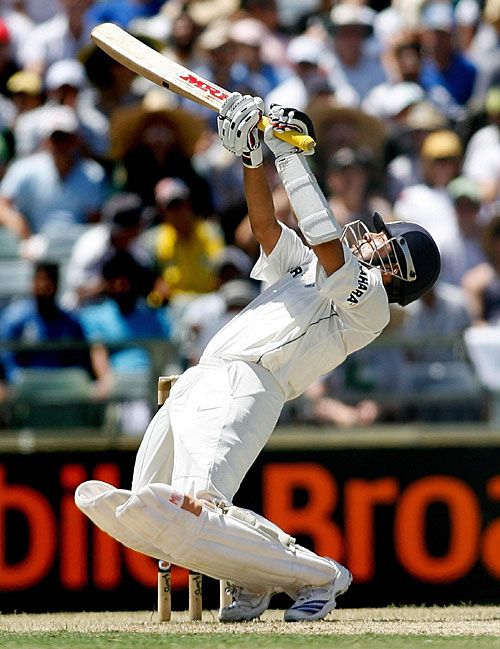
Tendulkar Tribute: How about Sachin the mortal?
Day1 – The toss coin (a gold coin) has Sachin embossed on it, All day 1 ticket holders get a brochure celebrating Tendulkar.
Day2 – All seats have a placard which when raised together make up a huge Tendulkar.
Day3 – 199 bunches of ballons with Sachin’s face on them will be floated to greet the legend.
Day4 – West Bengal chief minister is expected to felicitate Tendulkar.
Day5 – Rose petals weighing 199 Kg will be showered on Eden Gardens. Cricket Association of Bengal will present Sachin a silver banyan tree with 199 gold leaves.
(Phew! I am tired, could ‘ve written a whole article on them) You couldn’t fault Sachin if he actually starts considering himself ‘God’ after such opulent arrangements at Eden Gardens; or if he now ponders whether he is the biggest star this country has ever produced (Yes, I can see some SRK fans grinning)
The celebrations at Eden are a definitive culmination of the way Sachin has been revered all his life by fans. The man is called ‘God’ and treated no less. At times, this mania has been a bane, often snatching away from Sachin his personal time and space. But, what promoted this vehement fan infatuation? Was it the sandstorm at Sharjah where he dispirited a mighty Australia, his precocious innings at Perth in 1992 that announced Tendulkar, his belligerence as an opener in an age where chasing 300 in an ODI was unheard of or simply Sachin’s own model behaviour? In their own ways, all these factors contributed but something bigger too was at play. Sachin’s rise coincided with the most fruitful phase of India as a country. The liberalized economy provided an average Indian with many opportunities to look the world in the eye. Sachin was one of them. He became a formidable expression of the collective Indian pride which was on the rise. Through him, we were telling the world “We are no less”.
In the last decade, however, something about Sachin the cricketer changed. He was no more the destroyer who would single handedly coerce opposition into submission. Rather, Sachin became a monk whose batting style evoked quiet appreciation rather than blinding awe. This new Tendulkar copped a fair amount of criticism. At one point, the unthinkable happened – he was booed off in Wankhede after a measly 1 off 21 balls. Many ‘complained’ that the old charismatic batsman wasn’t on view anymore (After the 2007 WC debacle, Ian Chappell suggested that he retire).

One of the many frugal shots that Sachin began playing late in his career
But take this into account. In 2004, Sachin suffered the dreadful tennis elbow. Once operated, there was a rehabilitation that was equally painful. It forced him to use a lighter bat, invent some cheeky shots – the steer over the slips being the latest, and play more of those nudges and dabs that one normally associates with Gautam Gambhir. Yes, without doubt, Tendulkar the entertainer had lost a fair chunk of his appeal. Was it also true of Tendulkar the cricketer though?
After the 2003 World cup, the period in which Tendulkar is accused of being sedate, he scores runs at an average of 45.63 runs per match in one dayers. The overall career average is 44.83. More importantly, the resilient 175 against Australia in Hyderabad, the first individual 200 and the WC 2011 wins have all come during this period.
Tendulkar was a senior now; in fact, in terms of cricket years he was the senior most. The need to play your natural game irrespective of the situation is overemphasized. Unlike robots who can remain oblivious, human beings have to mould according to the circumstances. Take Dhoni’s case. He is hardly as flamboyant after taking over as captain as he was when first burst onto the scene. It was, thus, only natural that Sachin cut down on the risks and play the calm anchor who might look a little ugly but ensures that the team crosses the line. The two match winning knocks against Australia in the CB series 2008 finals were in complete contrast to the sandstorm mayhem but admirably they ensured that Indians left Australian shores a gleeful unit.

Sachin clearly revelled in the role of a mentor
So what is the point you may ask. The point is that the extra fraction of a second Sachin has while batting and his ethereal shot-making (the backfoot punch with minimal follow-through, the deft leg glance which he can play blindfolded) constitute a small part of the little master’s genius. Tendulkar’s true genius lies in this remarkable ability to accept his human fallibilities and and move on; almost like a river that comes up against a rock but instead of battling prefers to pass around it. The tennis elbow affliction was dealt with appropriate shots; the senior status with more responsible play and an ageing body with sufficient gaps between matches. At every turn where he has come face to face with a roadblock, Sachin riding on his unyielding will and genuine fondness for cricket, hoodwinking all obstacles, has found a long-lasting way out.
It is a wily diplomat at play who without compromising on the prime motive finds an amicable solution pacifying all the warring parties. Therein, for this writer, lies Sachin’s true genius. Sachin ‘the god’ is, after all, Sachin ‘the agile mortal’!